How to Use AI for Marketing Optimization Success
According to the 2025 AI and Marketing Performance Index, nearly three-quarters of respondents report that using AI accelerates their marketing growth by at least 10%. You need more installs, better conversions, and a higher return on ad spend. However, manual campaign setup, data cleanup, and A/B testing are slowing you down. You waste hours hopping between ad platforms, spreadsheets, and dashboards, struggling to figure out which creative or audience is most effective.
Every extra day you wait for test results costs you budget and momentum. Poor-performing ads continue to waste money, while your next big winner remains hidden in the noise. As your campaigns grow more complex, you risk falling behind competitors who can adapt and adjust their budgets more quickly.
With AI for marketing optimization, machine learning handles tasks like data cleaning, model training, and real-time predictions. By simply feeding your past campaign data into a managed service, it can automatically predict installs, tailor creative for each audience, and reallocate budget to top-performing ads.
In this blog, we’ll explain what AI-powered marketing optimization is and introduce its core technologies. We’ll show you how to set up predictive analytics, personalization engines, and dynamic creative testing. Finally, we’ll highlight the new AI-driven metrics you should track to measure the success of your campaigns.
What is AI‑Powered Marketing Optimization?
It involves using machine learning and generative AI to enhance and accelerate every stage of your campaigns, from planning and targeting to creative testing and performance monitoring. Instead of building and tuning algorithms yourself, you plug your data into managed services that handle model training, data cleanup, and predictions automatically.
Core technologies
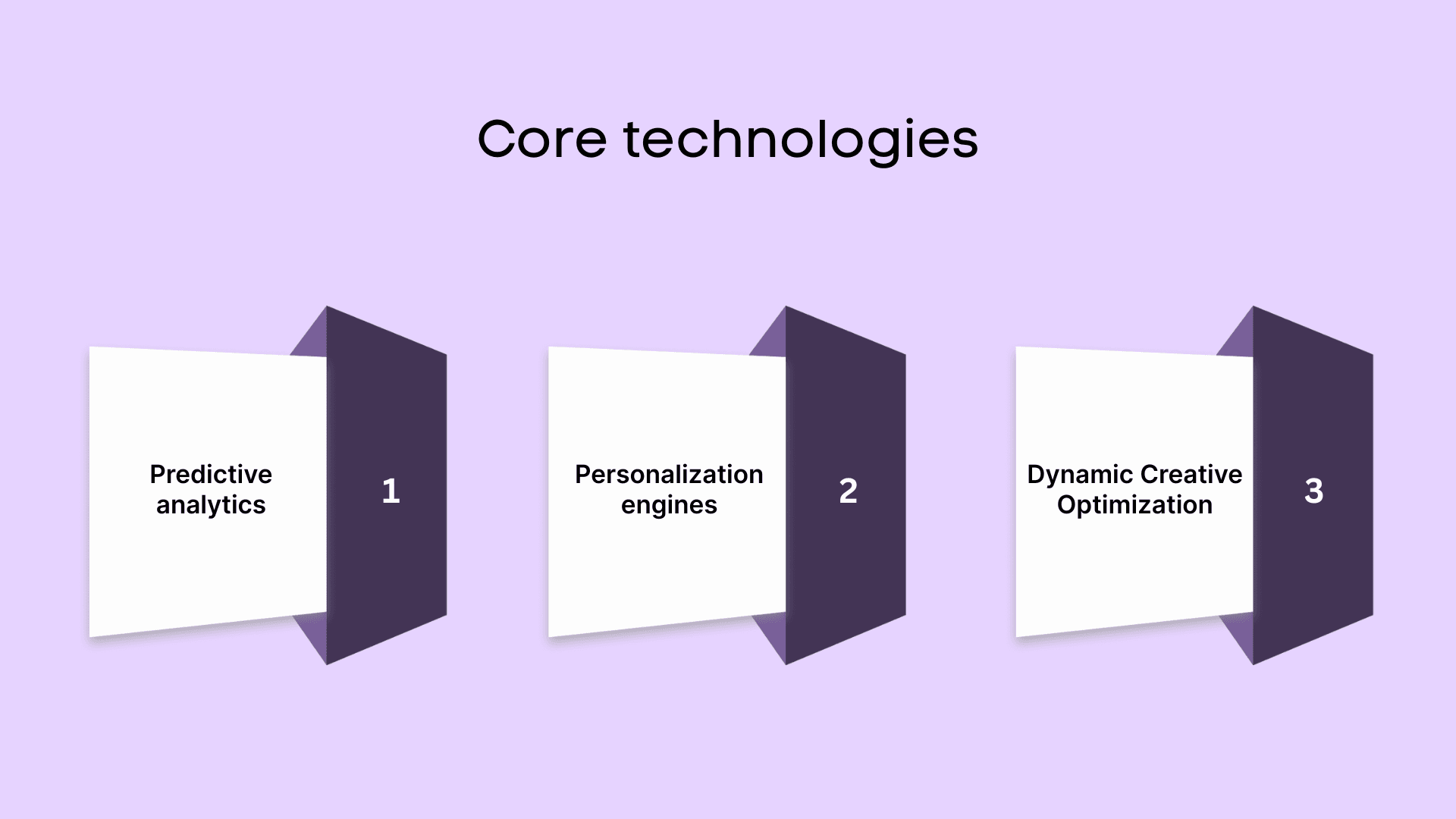
Here are three core technologies empowering your campaigns:
1. Predictive analytics
Forecast player actions like installs, churn, and in‑app spend without writing your own models. With Amazon Forecast, you upload your historical event data in a few clicks, and the service auto‑cleans missing values, selects algorithms, and delivers time‑series predictions via API or console.
2. Personalization engines
Show each player the right message at the right time by tailoring your creative for different segments. Adobe Target enables you to run A/B and multivariate tests with an intuitive visual editor, allowing you to swap images, offers, or headlines for each group. If you need deeper AI recommendations, Dynamic Yield’s Experience OS predicts individual preferences and serves personalized content across email, push, and in‑app channels.
3. Dynamic Creative Optimization (DCO)
Test and serve hundreds of ad variants automatically, then shift the budget to the winners in real-time. Google Studio's dynamic creatives feature uses a single HTML5 template and data feeds to swap headlines, images, calls to action, or URLs on the fly. And many DSPs, such as The Trade Desk, integrate Dynamic Creative Optimization (DCO) with automatic spend reallocation, so your top performers continue to receive more impressions without requiring manual work.
Why It Matters for Your UA Efforts
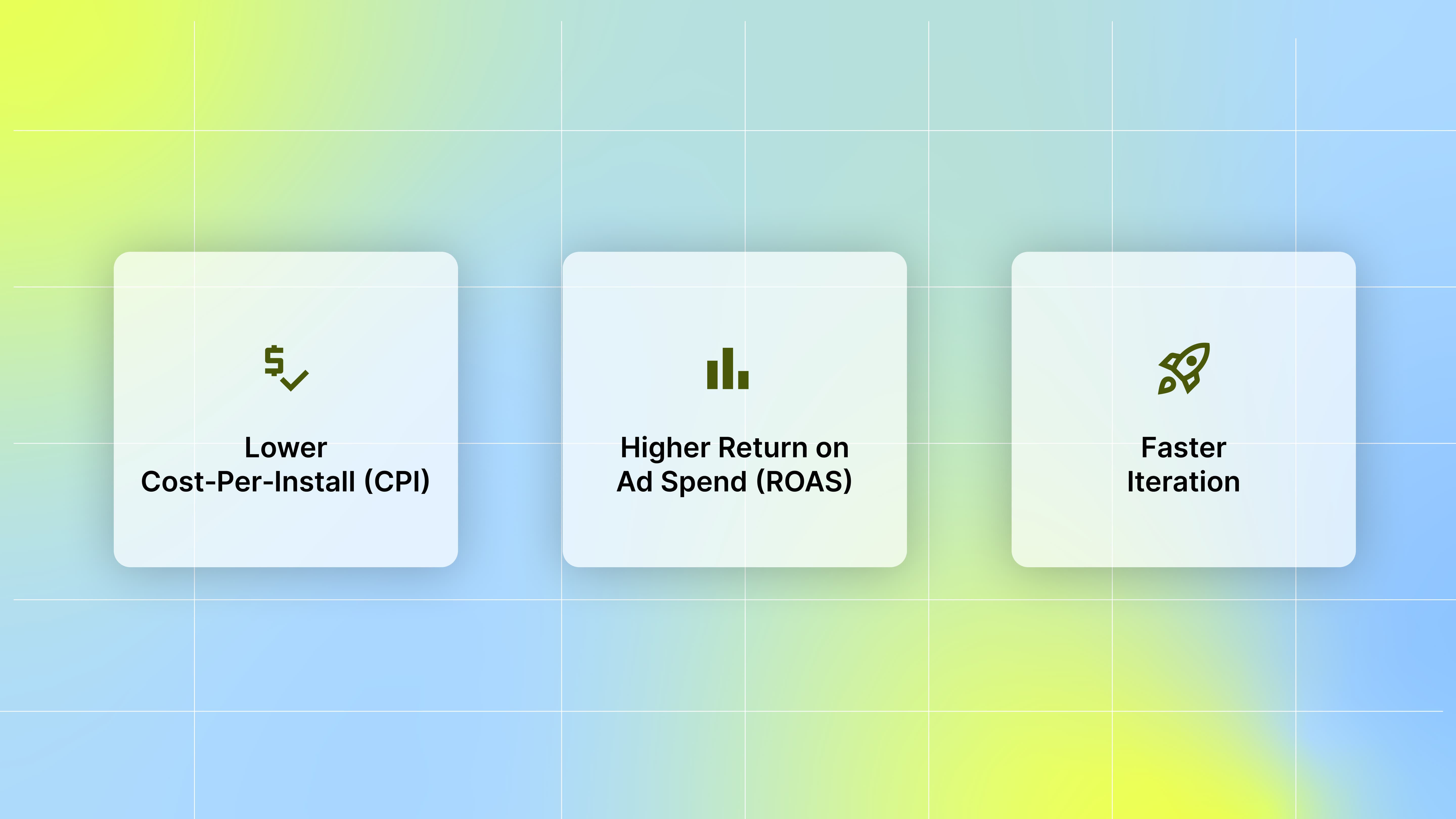
Here’s why these capabilities drive better user acquisition:
1. Lower Cost‑Per‑Install (CPI)
AI helps you pinpoint which ad creatives resonate best with your audience, reducing spend on underperforming assets. Tools like Uplifted and OfferFit analyze user engagement to identify high-converting creatives, enabling you to allocate your budget more effectively.
2. Higher Return on Ad Spend (ROAS)
AI predicts which users are most likely to engage and convert, enabling you to allocate your budget to high-value audiences. With Segwise Creative Analytics, you get a single, unified dashboard that pulls creative‑level ROAS, CPA, LTV, and conversion rates from Facebook, Google, TikTok, your Mobile Measurement Partners (MMPs), and more. Its tag‑level creative element mapping shows, for example, "this hook dialogue appears in 80% of our top‑performing ads," so you know exactly which creative levers move your ROAS needle, and can reallocate budget accordingly.
3. Faster Iteration
Manual A/B tests often drag on for weeks. Instead, Segwise lets you build custom dashboards and automated reports around your unique KPIs, refreshing in real time. As soon as certain tags or creative themes start to lose traction, you'll see it in the dashboard and can swap in fresh assets within hours, no more weeks‑long A/B test cycles.
By integrating AI into your marketing optimization strategies, you can achieve more efficient user acquisition, higher returns, and quicker adaptation to market changes.
Once you’ve got performance data flowing, the next step is to scale creative generation intelligently. That’s where AI brings serious efficiency to ideation and production.
Also Read: AI in Mobile Game Marketing and Advertisement: Key Stats & Insights
Creative Generation: From Concept to Asset
Converting interested players into active users hinges on two AI-driven capabilities: rapidly generating high‑impact ads and turning performance data into clear next steps. Here's how you can set that up today.
1. Ideation at Scale
Transform your high-level game insights and player personas into multiple fresh ad concepts in just minutes. For example, by using OpenAI's GPT-4.1 through the Chat Completions API, which can now process very large amounts of input text (up to 1 million tokens, or roughly hundreds of thousands of words), you can input details such as your game's core loop, key player segments, and promotional goals to generate various headlines and descriptions simultaneously.
Additionally, feed your top game insights and core player personas into a generative AI tool, like AdCreative.ai, to instantly generate dozens of distinct ad concepts. You simply upload a few bullet points about your game’s key features (e.g., “tower defense mechanics,” “daily reward streak”) and let the AI propose complete layouts with headlines and imagery in seconds.
2. Dynamic Creative Optimization (DCO)
Once you have your concept pool, DCO platforms proactively assemble and personalize the right mix of gameplay clips, character shots, and reward hooks for each audience segment (device, geography, in‑game behavior). Bannerflow's CMP utilizes dynamic media templates to integrate your latest game footage, promotional text, and local assets into pre-built layouts, then serves variants automatically based on live performance signals. This means you can run one campaign that truly adapts to player interests, boosting relevance and lift without extra manual work.
3. Your Next Steps
You should kick off by taking your top‑performing visuals, maybe that "first three wins get bonus coins"hook, and letting AI remix them into new variants. Utilize multivariate testing to identify which combinations of scenes, taglines, and CTAs generate the most taps and installs. Monitor conversion lifts (for instance, Meta advertisers have seen a 5% uplift using AI-powered recommendations) and lean into the hooks that drive success.
By feeding real performance data back into your AI tools and remixing your top hooks into new variants, you'll keep your creative pipeline full of high-impact ads.
Of course, generating creatives is only half the equation; you also need clear insights into what’s working. That’s where creative analytics tools step in.
Creative Analytics: Turning Data into Decisions
To decide which ads to run, you need clear, automated analytics. Segwise’s Creative Analytics delivers that with one unified view, so you can scale winners and stop budget‑draining ads.
One Place for All Your Creative Data: Stop jumping between Facebook Ads Manager, Google Ads, TikTok, and your MMP dashboard. See creative‑level ROAS, CPA, LTV, and conversion rates from every source on a single screen.
Tag‑Level Creative Element Mapping: Discover which specific elements, like a hook dialogue or character, drive performance. Spot patterns such as “80% of top‑performing ads use this background color,” with full MMP attribution built in.
Custom Dashboards & Reporting: Create dashboards tailored to the metrics that matter most to you. Create automated reports that show how creative changes move your ROAS, installs, or purchase rates across apps and campaigns.
Studio View for Multiple Projects: Manage analytics for all your apps, games, or brands from one interface. Switch between projects instantly, maintaining consistent performance tracking across your entire portfolio.
No‑Code Integrations with Top Ad Networks: Connect to Facebook, Google, TikTok, and your MMP without writing a single line of code. Data syncs automatically, so your analytics are always up to date.
With platforms like Segwise powering your analytics, you’ll turn raw campaign data into clear next steps, so you can double down on high‑impact creatives and pull back on underperformers without missing a beat.
To fully benefit from AI, it’s not enough to generate and analyze separately. The key is to connect these steps into one feedback loop.
Integrating Generation & Analytics
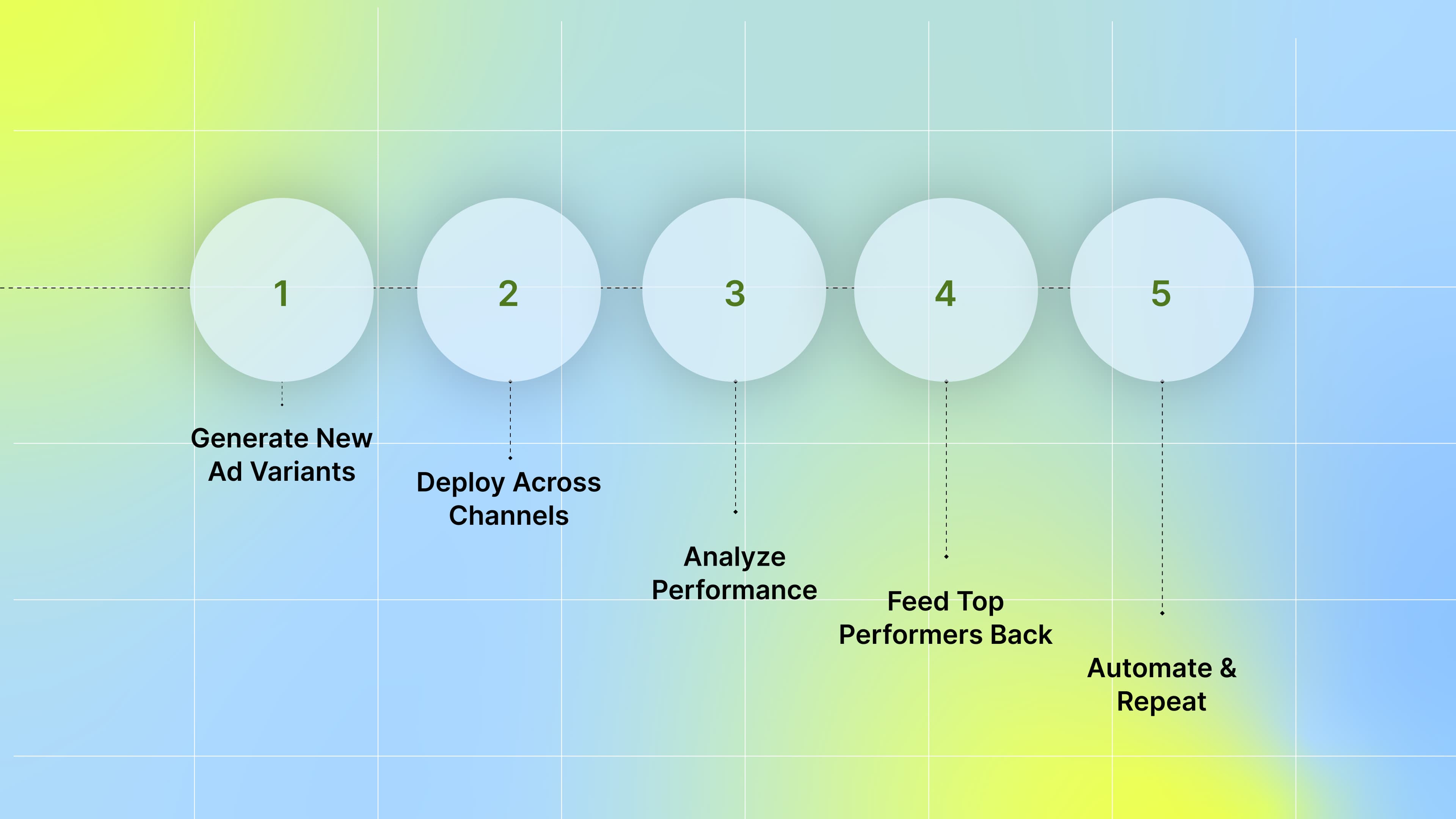
To link your creative generation and analytics into a seamless loop, follow these five steps -each powered by best‑in‑class tools and APIs.
1. Generate a pool of new ad variants
Use an AI creative API, such as AdCreative.ai’s AdCreative API, to spin up dozens of on‑brand ad variations in seconds. With a single POST request to /api/v1/creatives/generate, you supply your top game visuals, brief descriptions, and target audience notes, and the API returns ready‑to‑launch banners, videos, and copy sets. You can even track generation status programmatically via the Progress Tracking endpoint to know exactly when assets are live.
2. Deploy across channels
On Meta: Opt into Advantage+ Creative by hitting the Marketing API’s
/advantage_creativeendpoint when creating your ad or ad set. Meta’s system will automatically assemble multiple variations, such as single images, videos, and carousels, from your supplied assets and test them against your objectives.On Google: Use the Google Ads API’s
AdGroupAdService.MutateAdGroupAdsmethod to push your responsive display ads. Populate theResponsiveDisplayAdInfoobject with your AI‑generated images, headlines, and descriptions, and Google’s machine learning will stitch them together in real time for the Google Display Network.
3. Analyze performance proactively
Bring all your creative data into Segwise’s unified analytics dashboard. Segwise’s Creative Analytics AI Agent automatically tags each ad element (background, character, hook) and merges performance from Meta, Google, and CTV channels. You can filter by tag to see which music styles, reward hooks, or character shots drive the lowest cost per install and the highest early-LTV signals.
4. Feed top performers back into your AI generator
Pull the IDs of your highest‑performing variants from Segwise via its API. Then push those back into the AdCreative API as “seed creatives” or briefs for your next batch, ensuring the model learns from real winners. Segwise’s API access makes this custom integration straightforward: you fetch your weekly top‑10 creative IDs, package their metadata, and send it as input for your next generate call.
5. Automate and repeat continuously
Orchestrate the entire loop using a simple cron job, Airflow DAG, or Zapier workflow. Schedule daily generation jobs, deploy via Marketing and Google Ads APIs, trigger Segwise scans, and then push back new seed prompts, all without manual steps. Over time, this closed loop accelerates the decline in your cost-per-install and compounds revenue gains.
By automating each handoff, from AI creation to multichannel deployment to data-driven feedback, you’ll sharpen your ads more quickly and unlock sustained marketing optimization success.
To bring all this into your team’s daily workflow, here’s a simple way to get your setup off the ground using available tools and platforms.
Also Read: How to Combat Creative Fatigue with AI Solutions
Implementation Steps for Your Marketing Team
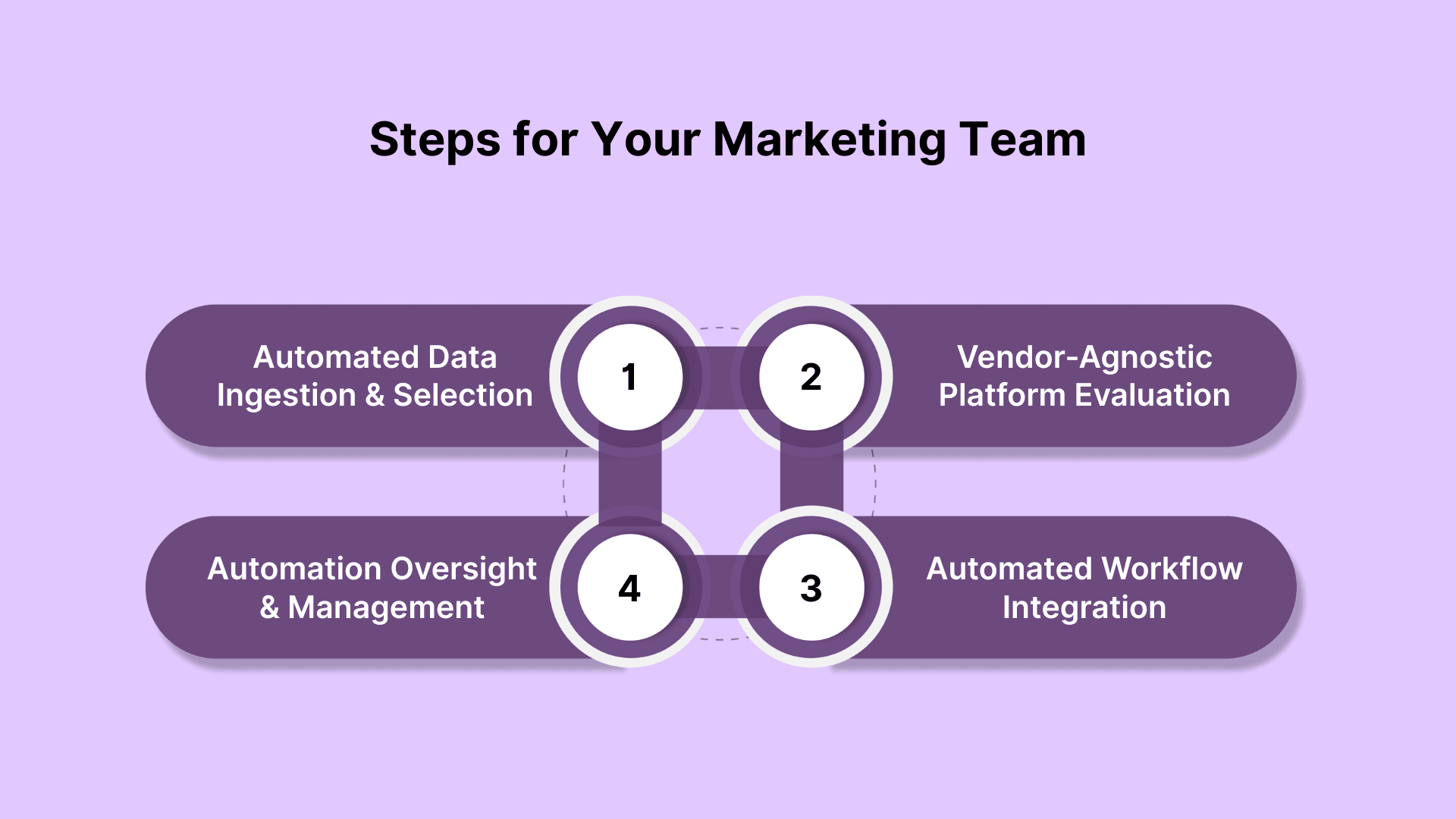
First, let’s outline the key phases you’ll automate: data capture, platform selection, workflow setup, and ongoing checks. Then you can plug in the right tools at each stage:
1. Automated Data Ingestion & Selection
Instead of downloading CSVs by hand, you can connect your ad networks and measurement/attribution tools to Segwise. It pulls in your UA campaign metrics, tags each creative asset (video, image, copy), and automatically flags the top performers for model training. That saves you roughly 20 hours a week on manual prep and immediately surfaces the most effective ads for AI to learn from.
2. Vendor‑Agnostic Platform Evaluation
Look for solutions that bundle predictive analytics, data ingestion, and creative analytics, all under one roof. Segwise is one option; it integrates with major ad networks and mobile measurement partners, forecasts ROAS, and provides a unified dashboard. When you compare platforms, rate them on:
Flexibility: Can you switch data sources quickly and easily?
Privacy Compliance: Are They CCPA (California Consumer Privacy Act) and GDPR (General Data Protection Regulation) Ready?
Ad‑channel integrations: Do they cover Meta, Unity, Ironsource, and TikTok out of the box?
3. Automated Workflow Integration
Chain your AI steps into a single, self‑serving pipeline:
Ingestion →Predictive scoring →Creative optimization →Deployment →Analysis →Refinement
For straightforward cross-application triggers, Zapier or n8n are effective. For instance, you can set up a trigger such as “when Segwise scores a creative above X, push it into your Meta Advantage+ feed” with minimal configuration.
For more complex workflows that require scheduling, retry logic, and logging, consider using enterprise-grade orchestration tools like ClickUp or Lark. These platforms offer advanced automation capabilities, including AI-driven task management and real-time collaboration features, to streamline and enhance your workflow processes.
4. Automation Oversight & Management
Even the most advanced AI requires a human review. Assign a pipeline owner whose job is to:
Monitor data‑pipeline health: Watch for missing feeds or stalled jobs.
Validate model outputs: Spot‑check which creatives the AI is promoting each week.
Manage exceptions: Handle edge cases your AI can’t score (like untagged playables).
By following these four steps, you’ll transition from manual handoffs to a continuous, AI-powered cycle that learns from each campaign. That means faster insights, more reliable optimizations, and, ultimately, stronger ROAS.
Once your system is up and running, you’ll want to measure its performance. Standard KPIs matter, but AI unlocks some new ones that help you quantify its added value.
Also Read: AI Tools to Create UA Ads for D2C Brands
Measuring AI Marketing Optimization Success
When you run AI‑driven campaigns, you still track your core user acquisition metrics, CAC, ROAS, CLV, and conversion rate, just like before. To see the extra boost you get from AI, add in three new measures and roll them up alongside your standard KPIs in a single dashboard.
Standard UA KPIs
CAC (Customer Acquisition Cost): How much you spend to get a new user
ROAS (Return on Ad Spend): Revenue divided by ad spend
CLV (Customer Lifetime Value): Total value a user brings over their lifetime
Conversion Rate: Percentage of ad clicks that become installs or purchases
AI‑First Measures
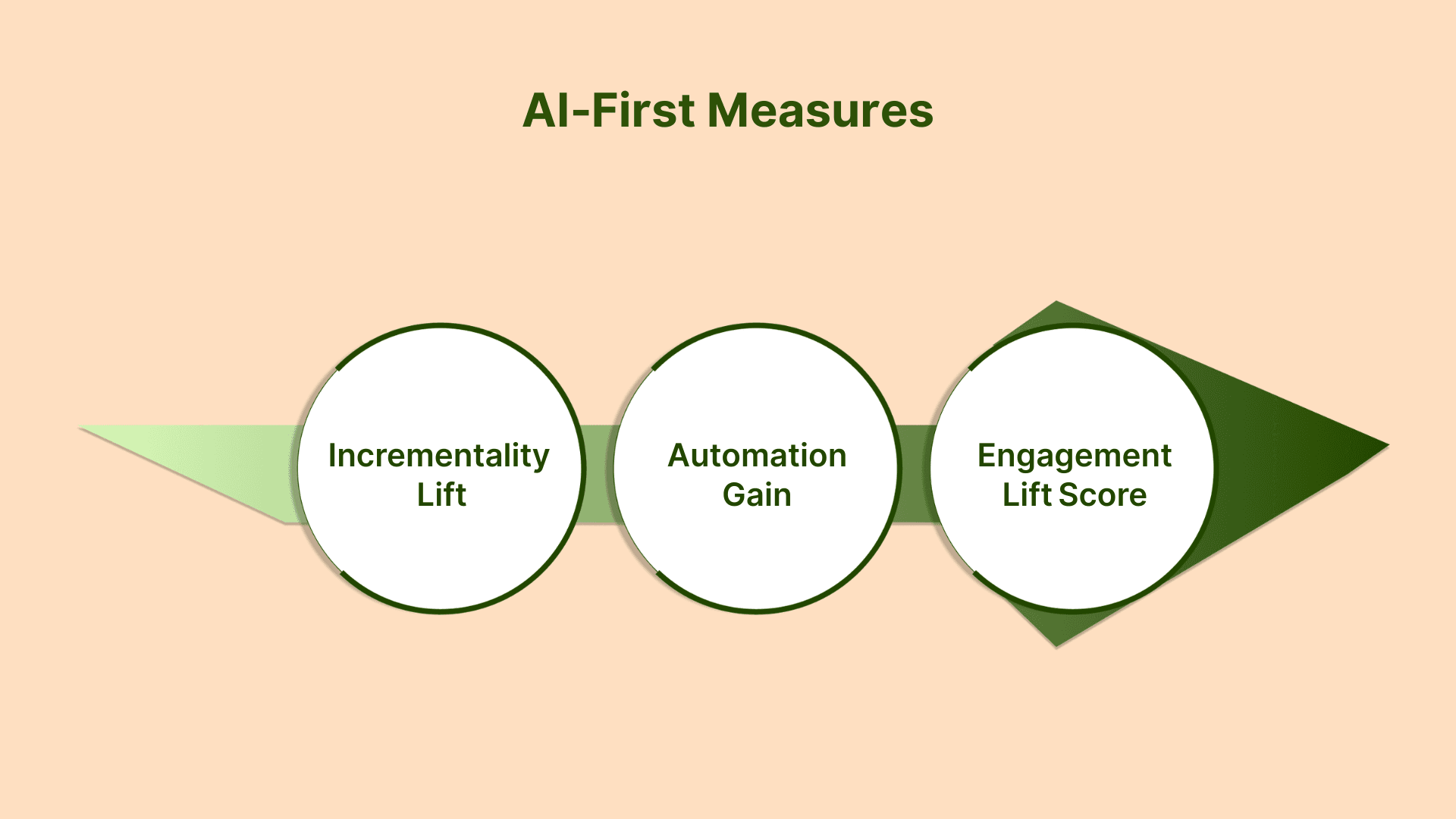
1. Incrementality Lift
Quantifies the extra installs, purchases, or revenue driven by your AI‑optimized ads beyond what would happen without them. You set up holdout tests, splitting similar users into test and control groups, and compare results. Holdout tests involve randomly assigning users to groups that either do or do not see AI-optimized ads, isolating the true effect of your campaigns on conversions. Tools like AppsFlyer Incrementality make this easy in your dashboard, automating group assignment and reporting so you can get unbiased lift numbers in minutes. Google Ads now also offers low‑spend incrementality tests with improved methods, so you can pinpoint exactly what’s adding value across your channels.
2. Automation Gain
Tracks how much time your team saves and how much faster you launch campaigns thanks to AI. For example, creative automation platforms like Hunch report up toan80% time savings on ad production by utilizing AI-powered templates and dynamic feeds. You measure this by comparing logged hours for manual tasks with what the tool records for automated workflows, or by using built-in reports in platforms such as Google Ads Performance Max, which now surfaces launch-speed improvements and automated bid adjustments in new reporting columns.
3. Engagement Lift Score
A simple composite that blends your AI‑personalized click‑through uplift with retention gains. Google Analytics 4’s cross-channel reporting aggregates data from multiple platforms, while AI-driven measurement identifies real-time improvements in click-through rates attributable to personalization. Combine that with retention lift insights from Performance Max’s new retention goals, which let you bid smarter for returning users and see how AI changes hold and return rates over time.
Putting It All Together
Use a dashboard tool or your MMP’s built‑in dashboard to layer these three AI‑First Measures alongside CAC, ROAS, CLV, and conversion rate. In one view, you’ll see:
Your baseline KPIs for overall performance
How much extra lift AI delivered (Incrementality Lift)
How many hours AI saved your team (Automation Gain)
The combined boost in clicks and retention (Engagement Lift Score)
With all these in one place, you’ll know exactly which AI optimizations are moving the needle and where to focus next.
Also Read: Creative Ad Strategies from New Mobile Games That Hit 30M+ Downloads
Conclusion
The true value of AI-driven marketing optimization is seen in its ability to lower your cost per install, improve return on ad spend, and accelerate the process of testing and deploying successful creatives. By automating key tasks, such as predicting high-conversion audiences, generating and dynamically testing multiple ad variations, and quickly identifying which creative elements boost or hinder performance, you enable your team to focus on strategy instead of managing data.
Segwise slots right into this workflow with its AI Creative Analytics agents that tag every visual, text, and audio element across Meta, Google, TikTok and other major ad networks, your MMP, and more, then unifies them into a single dashboard so you can see, for example, exactly which headline or character shot lifts ROAS and which themes are losing steam. Everything connects without writing a line of code or needing engineers, and you’ll save hours each week on manual tagging and reporting.
Tie those top‑performing creative IDs back into your generative AI workflows to keep seeding new variants with proven hooks, and you’ll lock in continuous CPI reduction and ROAS improvement. Ready to streamline your creative analytics and accelerate performance gains? Start a 14‑day free trial.
FAQs
1. How can AI help reduce user acquisition costs for mobile games?
AI can optimize ad targeting and creative performance, ensuring that your budget is spent on high-converting audiences and effective creatives, thereby lowering cost-per-install (CPI) and improving return on ad spend (ROAS).
2. What are the key performance indicators (KPIs) to track when using AI in UA?
In addition to traditional metrics like CPI and ROAS, consider monitoring AI-specific KPIs such as Incrementality Lift, Automation Gain, and Engagement Lift Score to assess the effectiveness of AI-driven optimizations.
3. How does AI contribute to creative optimization in mobile game marketing?
AI enables dynamic creative optimization by automatically generating and testing multiple ad variants, allowing for real-time adjustments and improved engagement without manual intervention.
4. What role does AI play in audience segmentation for user acquisition?
AI analyzes user behavior and attributes to create precise audience segments, enabling targeted campaigns that reach the most promising players, thereby enhancing user acquisition efficiency.
5. How can AI assist in automating campaign workflows for UA teams?
AI tools can automate data ingestion, predictive scoring, creative optimization, deployment, and performance analysis, streamlining workflows and allowing UA teams to focus on strategic decision-making.
Comments
Your comment has been submitted successfully!